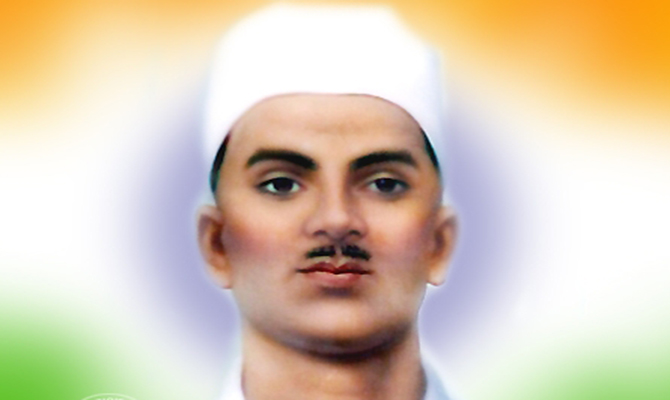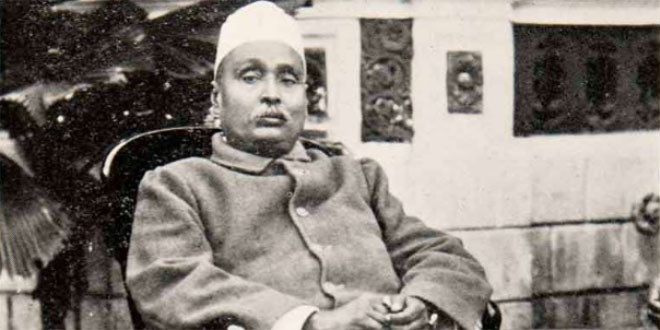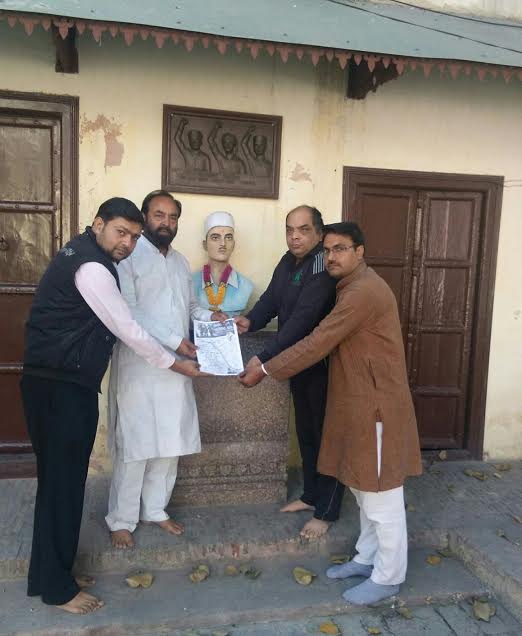Any recounting of the history of the Indian freedom struggle is incomplete without looking into the contribution of the trio of Bhagat Singh, Sukhdev Thapar and Shivaram Hari Rajguru, who faced the gallows for the sake of the freedom struggle. Ironically, none of the 10 people we asked knew the last name of the great hero Sukhdev, let alone his life’s story. This is our humble attempt to present a brief chronicle of Sukhdev Thapar, less popular than his ‘azadi-mates’ and definitely less written about. He was the organiser of the Punjab party, the one who built its edifice brick by brick.
Sukhdev Thapar was a brave and fearless man. Though he is less popular and less written about than his friend Bhagat Singh, he was a man of exceptional integrity. In reality, Bhagat Singh was the political mentor of the Punjab party while Sukhdev was the organiser – the one who built its edifice brick by brick.
Early life
Sukhdev was born on May 15, 1907 at Naugarh in Ludhiana in Punjab. His father’s name was Ram Lal while his mother’s name was Ralli Devi. The family claimed its ancestry traced back to Tapoor in Kabul. The word ‘Tapoor’ gradually changed to Thapar when they settled in Ludhiana in Punjab. Their ancestors are said to have fought against Mahmud of Ghazni, who had invaded India in the early eleventh century and plundered its enormous wealth.
Sukhdev’s father died when he was only three years old. He was brought up by his uncle Lala Achintram. From a very early age, Sukhdev saw and was a victim of the repressive actions of the British Empire, leading him to later make a vow to sacrifice his life for the nation.
Sukhdev was subjected to physical abuse as a child, some of it self-inflicted. It is said he once used nitric acid to remove a tattoo of the symbol ‘Om’ on his skin, and stoically bore a caning at school for not saluting a British military officer. He reportedly gave himself the nickname ‘Maarkhaana’, which was the equivalent of the English term ‘punching bag’.
To fight against the British, Sukhdev joined the Hindustan Socialist Republican Association (HSRA) and organised revolutionary cells in Punjab and other areas of North India, evangelising the concept of freedom struggle among the youth in National College in Lahore and inspiring them with facts about India’s glorious past.
Sukhdev, along with other revolutionaries, started the ‘Naujawan Bharat Sabha’ in Lahore. This organisation was involved in various activities, including gearing up the youth for the freedom struggle, inculcating a rational scientific attitude and putting an end to communalism and untouchability.
Avenging death of Lala Lajpat Rai
The Simon Commission was created by the British government in the year 1928 to report on the political situation in the country at that time. Indian political parties boycotted the commission as it did not have any Indian representation. There were nationwide protests against the commission. In Lahore on October 30, 1928, a non-violent protest led by Lala Lajpat Rai was met with a violent police response. James A. Scott, the superintendent of police, ordered the police to lathi charge the protesters and specially assault Lajpat Rai, who was grievously injured.
Lajpat Rai was met with a violent police response. James A Scott, the superintendent of police, ordered the police to lathi charge the protesters and specially assault Lajpat Rai, who was grievously injured.
Lala Lajpat Rai later died on November 17, 1928. It was widely assumed that Scott’s order and the injuries he suffered led to his death. However, when this matter was put forward in the British Parliament, they completely denied the government’s role in Rai’s death.
Miffed with the British government’s attitude Sukhdev Thapar with Bhagat Singh along with Shivram Rajguru, Jai Gopal and Chandra Shekhar Azad vowed to avenge Lala Lajpat Rai’s death by assassinating Scott.
As per the plan on a specific day, Jai Gopal was supposed to identify Scott and signal Singh to shoot Scott. However, in a case of mistaken identity, Jai Gopal signalled Bhagat Singh on the appearance of J P Saunders, an assistant commissioner of police, who was shot by Shivram Rajguru and Bhagat Singh while leaving the district police headquarters in Lahore in the evening on December 17, 1928.
Hurling of bombs at Central Assembly Hall
In order to protest against the Trade Dispute Bill and Public Safety Bill, Bhagat Singh planned to hurl bombs in the parliament to attract the attention of the British government. However, Chandra Shekhar Azad disapproved of the plan as he considered Bhagat’s life to be valuable to the Hindustan Republican Association.
Finally, Bhagat Singh did come around to convincing Azad and along with Batukeshwar Dutt carried out the protest, for which they were arrested. After Bhagat Singh’s arrest, the responsibility of managing the daily activities of HSRA fell on Sukhdev. But a mole in the party betrayed the HSRA’s locations and it members. As a result, Sukhdev was arrested.
He was kept in jail along with Bhagat Singh and Rajguru where he participated in hunger strike with his comrades and other members of HSRA for being given proper treatment in prison.
While moving to the hangman's platform Sukhdev and his comrades shouted slogans like "Long Live the revolutionaries" "Down with imperialism". They were singing, "Sarfaroshi Ki Tamanna Ab Hamare Dil Me Hai" "Mai Rang De Mera Basanti Chola". The trio was hanged at 7:15 pm on March 23. They were cremated near Ganda Singh Wala village in Ferozepur on the edge of the river Sutlej. Sukhdev was just 24 years old when he attained martyrdom.
Shaheed Sukhdev Thapar Memorial Trust
To rekindle the spirit of patriotism and propagate the contribution of Sukhdev in the freedom struggle, the Shaheed Sukhdev Thapar Memorial Trust was founded in 1950. A hawan yagna is performed each year on May 15, the birthday of Sukhdev, to pay tribute to this great martyr. Activities are also performed on March 23 to commemorate the martyrdom day of Sukhdev, Bhagat Singh and Rajguru.
Successive Punjab governments have done little more than talk about preserving the memory of freedom fighters. Even the birthplace of Sukhdev in Naugarh was occupied and it was only in 2007 that the members of Shaheed Sukhdev Thapar Memorial Trust were successful in vacating the place from the occupiers. The Trust along with mandir Chuhamal Thapar Baradhari had to pay a sum of INR 5 lakh (Approx. SGDs 10,700) for the vacation of the house. Later, this place was renovated.
In a chat with Connected to India, Ashok Thapar, president of Shaheed Sukhdev Thapar Memorial Trust said, “It is high time that people should know about the great freedom fighters of this land. Sukhdev was a great patriot who sacrificed his life at a very young age. We have a small memorial at the birthplace of Sukhdev where people from all walks of life come and pay tribute.”
He further added, “We also organise free medical camps, distribute free rations to the needy on the birthday and martyrdom day of Sukhdev. We also provide study materials to the needy students.”
Tribhuvan Thapar, a descendant of Sukhdev said, “The bravery of Sukhdev has attracted people from all over the country, especially NRIs, who come to this place to pay homage. Recently, students from Australia and Germany visited the place. We want the government to provide space so that we can open a school for children and a hospital for the needy and name it Sukhdev in memory of the great freedom fighter.”
He also said that not a single postal stamp has been issued in memory of Sukhdev, though there was a plan some years ago.
National Martyrs Memorial
It is the place which marks the location where Sukhdev Thapar, Bhagat Singh and Rajguru were cremated on March 23,1931 on the banks of the Sutlej river.
It is also the cremation place of Batukeshwar Dutt (died 1965) who was also involved in bombing the Central Legislative Assembly with Bhagat Singh. Bhagat Singh’s mother Vidyawati was also cremated there in accordance with her last wish, and later she was awarded the title of Punjab Mata (Mother of Punjab).
The memorial is located just one kilometre from the India-Pakistan border on the India side. After partition, the cremation spot went to Pakistan but on January 17, 1961 this martyr’s land was received in exchange for 12 villages near the Sulemanki Headwork (Fazilka) to Pakistan.
Every year on the March 23, Shaheedi Mela is observed at this National Martyrs Memorial at Hussainiwala, in which thousands of people pay their homage. The day is also observed across the state of Punjab.
Jab shaheedon ki arthi uthe dhoom se,
Desh walon tum aanso bahana nahin,
Par manao jab Azaad Bharat ka din,
Us ghari tum humein bhool jaana nahin,
Laut kar aa sake na jahan mein to kya,
Yaad banke dilon mein to aa jayenge.
(When the funeral procession of martyrs will be taken out,
Countrymen, do not shed tears,
But when you celebrate the day of India’s Independence,
You should not forget us,
Though we could not return to this world,
But we still come to your hearts through memories)
These lines bring tears in our eyes when we remember the sacrifice of Sukhdev Thapar, Bhagat Singh and Rajguru. Though we cannot repay the freedom fighters, at least we can make an effort to know about them and also educate our children about them.








